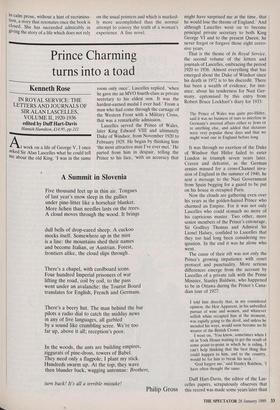Unable to climb out of the abyss
Anita Brookner
CAT'S EYE
by Margaret Atwood
Bloomsbury, £12.95, pp.421
It takes something of a heroine — and Margaret Atwood is definitely a heroine to both readers and writers of women's fiction — to turn the tables on her own kind. In this long and elegiac novel the narrator, Elaine Risley, whom we may take to be the author's alter ego, reviews her life from a position of maturity and some eminence. She is fiftyish, an established painter on the eve of a retrospective, a wife (twice) and a mother. She is no more confused than any other woman of her age, rather less so, in fact, although the new world-class Toronto in which the retrospective is to be held is very different from the nondescript city in which she spent her childhood. Camping out in the studio that still belongs to her first husband, Jon, and with a little time to spare before her big night at the gallery, Elaine embarks on a more personal retrospective and reviews her own life, concentrating on the years of child- hood, which, contrary to received wisdom, failed to define the adult she was to become. Successful now, she was a failure then, and her failure was due to a specific cause, or rather to a specific person: Cordelia, her best friend.
Is this post-feminism? Are women, to whom a certain amount of mourning is a natural function, about to stop taking it out on men, or their mothers, and to start charting certain injuries dealt out before puberty? For, no mistake, this novel is about mourning, about the irreparable, and the note of subdued grief is sustained throughout. Much of this, of course, has to do with being 50 and coming to terms with age and change: parents dying, brother killed, and love scaled down from passion to modest companionship. But a primal fear remains from childhood, and the middle-aged Elaine imagines that she sees her tormentor, Cordelia, around every corner. Even reduced to a shadow or a revenant, Cordelia retains her frightening power.
This power was originally vested in a little girl, but a little girl who had all the potential of an extremely manipulative woman. The young Elaine, daughter of unworldly parents, and their equal in innocence, was delighted to make friends with Carol, Grace and Cordelia, walked with them to school and played with them on the way home. Of these three, Carol was the only one who could be called normal, or at least normal for a child. Grace was the daughter of evangelical parents who considered Elaine a heathen and tried to capture her for the church, while Cordelia was simply prestigious, for no reason that the child Elaine could understand.
The quartet turned out, in the desolating way in which these things take place in childhood, to be three against one. It snows a lot in Toronto, and on a darkening winter afternoon Cordelia threw Elaine's hat into a ravine and ordered her to go down and fetch it. This was extremely hazardous. In addition, she was supposed to count to a hundred and not to begin the ascent until she had done so. Through snow and melting ice Elaine crashes down into the river below, begins to succumb to frostbite, sees no help at hand (for her friends have decamped) and is rescued by her mother after hallucinating a vision of the Virgin Mary. Many years later her mother tells her that the other three girls had called at the house to warn her not to expect Elaine who had been kept in at school. It was only because the mother became suspicious that Elaine was sought and rescued.
The point of this incident is that had the girls been older this would have been a clear case of attempted murder. Hence the fear that dogs Elaine in adulthood, although she knows — because she has seen this with her own eyes — that Cordelia is in fact mad. Cordelia is one of those rare delinquent personalities more common in life than in fiction, able to harry, bamboozle, and instil guilt into those unfortunate enough to bend to their will. One enters into such associations out of sheer ignorance. Elaine, who can paint every memory of her childhood (and her paintings are very well described), cannot paint Cordelia, although she knows her to be safely detained in a private nursing home. Cordelia is too imminent, too im- manent, to be relegated to a canvas. As an incarnation of evil she is still around.
• This is very well done. The bewilder- ment of childhood, its inability to gauge its own entitlements, is beautifully conveyed, and is all the more powerful for being understated. The sadness that falls on the novel stems from the child Elaine's lack of understanding and the mature Elaine's failure to recover from the incident of the ravine. At least, her recovery, such as it is, is converted into compensation.
There is no doubt that nasty children can inflict as much damage as their older selves. Elaine's love affairs, her marriages, cannot efface the memory of childhood trauma: they do not weigh sufficiently in the balance. Margaret Atwood has written,
in calm prose, without a hint of recrimina- tion, a story that resonates once the book is closed. She has succeeded admirably in giving the story of a life which does not rely on the usual pointers and which is marked- ly more accomplished than the normal attempt to convey the truth of a woman's experience. A fine novel.


















































 Previous page
Previous page